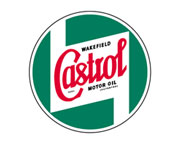
Castrol Classic Oil With ZDDP Anti-Wear Additive
 Established in 1899, originally as C.C. Wakefield, Castrol launched their first lubricant for cars in 1906 and have been at the leading edge of lubrication technology ever since. With the introduction of low viscosity engine oils and changes to anti-wear additives in modern oils in recent years, owners of veteran, vintage and classics are asking whether modern oils are suitable for their cars.
Established in 1899, originally as C.C. Wakefield, Castrol launched their first lubricant for cars in 1906 and have been at the leading edge of lubrication technology ever since. With the introduction of low viscosity engine oils and changes to anti-wear additives in modern oils in recent years, owners of veteran, vintage and classics are asking whether modern oils are suitable for their cars.
Choosing the correct lubricant for your veteran, vintage or classic vehicle is essential to ensure peak running and maximum wear protection. The technology of older vehicle engines is very different from today's modern cars, so to assist owners, Castrol reintroduced their older brands with their ‘Classic Range’ in the early 1990s. These Classic oils are produced to original viscosities and importantly have retained the necessary levels of additives including anti-wear additive ZDDP (zinc dialkyldithiophosphate) appropriate for the technology of the engines they are designed for and to provide overall protection. The ZDDP levels are appropriate for engines that are in use or running-in, including those fitted with new or reconditioned components, where care should always be taken to follow the manufacturers’ recommendations when breaking in new components such as camshafts.
ZDDP additive provides a high level of anti-wear protection, but its phosphorus content is harmful to catalytic converters and other emission equipment fitted to many modern vehicles. It has therefore been reduced in the latest specification oils, designed for engines using the latest surface hardening technology and meeting the latest emission requirements for modern vehicles. These requirements also necessitate the use of other new emission equipment friendly additives not designed for use in veteran, vintage and classic car engines.
Oil formulations required for today’s modern vehicles are very different from formulations needed for older vehicles, having thinner viscosity and alternative additive technology as stated earlier, making them generally unsuitable for use in older engines. This has been done in conjunction with new vehicle manufacturers who have increased the surface hardening of engine components to receive maximum protection from the new additives. Oils for modern engines comply with the latest API ratings and are designed for modern engine technology with tight tolerances and compatibility with catalytic converters. A car engine of old design has very different characteristics, with cork, graphite or rope seals, low pressure cog driven oil pumps, wider oil-ways with greater dependence on ‘splash’ and ‘cling’ lubrication, lower revving with lesser machine tolerances. Such widely different specifications demand totally different lubricants of thicker viscosity with appropriate additives specially included for the work they have to do. Oils even of the same viscosity, supplied by different oil companies can have radically different formulations and thus have significantly different performance characteristics. Oil classifications are designated ‘S’ (for spark ignition petrol engines) and ‘C’ (for compression ignition diesel engines). Oil classifications for older petrol vehicles range from SA for vehicles from the turn of the last century to SH, to the late 1980s and early ‘90s.
- Inadequate anti-wear additive (ZDDP) and the oil film between moving parts breaks down prematurely, resulting in metal to metal contact and damage to reground or new engine components particularly on run-in.
- Inadequate detergent will result in gum and lacquer clinging to the hotter engine components.
- Too much detergent can cause a build-up of metallic ash in the combustion chambers of older engines. In older engines with traditionally high oil consumption, this will cause detonation and pinking. In older engines where the carbon has built up over a number of years the detergents can also have a scouring effect causing the carbon to flake off, blocking up oil galleries and spray jets. High levels of detergent will ‘wash’ traces of carbon from seals and gaskets, revealing oil leaks.
- Inadequate anti-oxidant and the oil will permanently thicken during high temperature motoring, with large amounts of gum and varnish clogging filters and piston rings.
- Inadequate corrosion inhibitors and engine internals become pitted with corrosion and rust from acids and water formed during combustion.
- Inadequate dispersing results in soot, wear metals and the by-products of combustion settling out in the sump to form a thick sludge that will block filters and oil ways.
- Inadequate pour point depressant and the oil ceases to flow at low temperatures, with excessive strain on the oil pump or in certain cases, oil starvation on start-up causing complete failure of the lubrication system.
For older vehicles; veteran, vintage and classic, use an oil of the correct viscosity as recommended by the vehicle manufacturer and shown in your vehicle’s handbook. Where your vehicle requires a specific viscosity such as 30, 40, 50 and 20w-50, avoid using inappropriate low viscosity engine lubricants designed for modern vehicles such as 0w, 5w, 10w, 15w.
Castrol’s vehicle lubrication records date back beyond the turn of the last century, detailing lubricant specifications for engine oils, gear oils and greases right through to today's classics, so to find out which Castrol grade is right for a vehicle, owners can simply refer to their vehicle handbook and select that grade from Castrol’s Classic range. Castrol’s Classic engine oils XL30, XXL40, GP50 and XL20w-50 are formulated to the original viscosities and contain the necessary levels of ZDDP anti-wear additive to provide appropriate protection for veteran, vintage and classic engines. The range is available throughout the UK via leading car specialists. For further information either telephone the Castrol Classic helpdesk on 01954 231668 or visit www.castrol.com/uk/classics
Legal | Privacy | Contact Us | Search | Site Map
Volvo Owners' Club Limited® 1962-2025

